Synaptic organization of thalamocortical axon collaterals in the perigeniculate nucleus and dorsal lateral geniculate nucleus
- PMID: 18314907
- PMCID: PMC2561320
- DOI: 10.1002/cne.21671
Synaptic organization of thalamocortical axon collaterals in the perigeniculate nucleus and dorsal lateral geniculate nucleus
Abstract
We examined the synaptic targets of large non-gamma-aminobutyric acid (GABA)-ergic profiles that contain round vesicles and dark mitochondria (RLD profiles) in the perigeniculate nucleus (PGN) and the dorsal lateral geniculate nucleus (dLGN). RLD profiles can provisionally be identified as the collaterals of thalamocortical axons, because their ultrastrucure is distinct from all other previously described dLGN inputs. We also found that RLD profiles are larger than cholinergic terminals and contain the type 2 vesicular glutamate transporter. RLD profiles are distributed throughout the PGN and are concentrated within the interlaminar zones (IZs) of the dLGN, regions distinguished by dense binding of Wisteria floribunda agglutinin (WFA). To determine the synaptic targets of thalamocortical axon collaterals, we examined RLD profiles in the PGN and dLGN in tissue stained for GABA. For the PGN, we found that all RLD profiles make synaptic contacts with GABAergic PGN somata, dendrites, and spines. In the dLGN, RLD profiles primarily synapse with GABAergic dendrites that contain vesicles (F2 profiles) and non-GABAergic dendrites in glomerular arrangements that include triads. Occasional synapses on GABAergic somata and proximal dendrites were also observed in the dLGN. These results suggest that correlated dLGN activity may be enhanced via direct synaptic contacts between thalamocortical cells, whereas noncorrelated activity (such as that occurring during binocular rivalry) could be suppressed via thalamocortical collateral input to PGN cells and dLGN interneurons.
(c) 2008 Wiley-Liss, Inc.
Figures
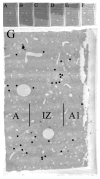


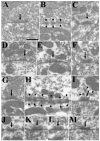
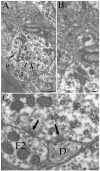
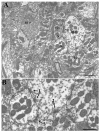
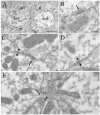


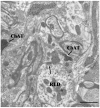

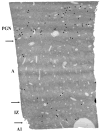
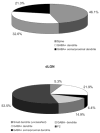
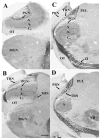
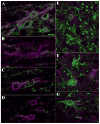
Similar articles
-
Ultrastructure and synaptic relations of neural elements containing glutamic acid decarboxylase (GAD) in the perigeniculate nucleus of the cat. A light and electron microscopic immunocytochemical study.Exp Brain Res. 1984;56(1):115-25. doi: 10.1007/BF00237447. Exp Brain Res. 1984. PMID: 6381084
-
A quantitative study of synaptic contacts on interneurons and relay cells of the cat lateral geniculate nucleus.Exp Brain Res. 1991;86(2):257-70. doi: 10.1007/BF00228950. Exp Brain Res. 1991. PMID: 1756802
-
Relative distribution of synapses in the pulvinar nucleus of the cat: implications regarding the "driver/modulator" theory of thalamic function.J Comp Neurol. 2002 Dec 23;454(4):482-94. doi: 10.1002/cne.10453. J Comp Neurol. 2002. PMID: 12455011
-
GABA-containing neuronal processes in normal and cortically deafferented dorsal lateral geniculate nucleus of the cat: an immunogold and quantitative EM study.Exp Brain Res. 1991;83(3):562-74. doi: 10.1007/BF00229835. Exp Brain Res. 1991. PMID: 2026198
-
Synapses, axonal and dendritic patterns of GABA-immunoreactive neurons in human cerebral cortex.Brain. 1990 Jun;113 ( Pt 3):793-812. doi: 10.1093/brain/113.3.793. Brain. 1990. PMID: 2194628 Review.
Cited by
-
Transient expression of heavy-chain neurofilaments in the perigeniculate nucleus of cats.Brain Struct Funct. 2024 Mar;229(2):489-495. doi: 10.1007/s00429-023-02752-6. Epub 2024 Jan 24. Brain Struct Funct. 2024. PMID: 38265459
-
Subcellular Targeting of VIP Boutons in Mouse Barrel Cortex is Layer-Dependent and not Restricted to Interneurons.Cereb Cortex. 2017 Nov 1;27(11):5353-5368. doi: 10.1093/cercor/bhx220. Cereb Cortex. 2017. PMID: 28968722 Free PMC article.
-
3D electron microscopy and volume-based bouton sorting reveal the selectivity of inputs onto geniculate relay cell and interneuron dendrite segments.Front Neuroanat. 2023 Mar 17;17:1150747. doi: 10.3389/fnana.2023.1150747. eCollection 2023. Front Neuroanat. 2023. PMID: 37007643 Free PMC article.
-
Thalamic burst firing propensity: a comparison of the dorsal lateral geniculate and pulvinar nuclei in the tree shrew.J Neurosci. 2011 Nov 23;31(47):17287-99. doi: 10.1523/JNEUROSCI.6431-10.2011. J Neurosci. 2011. PMID: 22114295 Free PMC article.
-
Optogenetic stimulation of the corticothalamic pathway affects relay cells and GABAergic neurons differently in the mouse visual thalamus.PLoS One. 2012;7(9):e45717. doi: 10.1371/journal.pone.0045717. Epub 2012 Sep 20. PLoS One. 2012. PMID: 23029198 Free PMC article.
References
-
- Abramson BP, Chalupa LM. The laminar distribution of cortical connections with the tecto- and cortico-recipient zones in the cat’s lateral posterior nucleus. Neuroscience. 1985;15:81–95. - PubMed
-
- Ahlsén G, Lindström S. Excitation of perigeniculate neurons via axon collaterals of principal cells. Brain Res. 1982;236:477–481. - PubMed
-
- Ahlsén G, Lindström S, Sybirska E. Subcortical axon collaterals of principal cells in the lateral geniculate body of the cat. Brain Res. 1978;156:106–109. - PubMed
-
- Ahlsén G, Lindström S, Lo FS. Functional distinction of perigeniculate and thalamic reticular neurons in the cat. Exp Brain Res. 1982;46:118–126. - PubMed
Publication types
MeSH terms
Substances
Grants and funding
LinkOut - more resources
Full Text Sources
Miscellaneous

